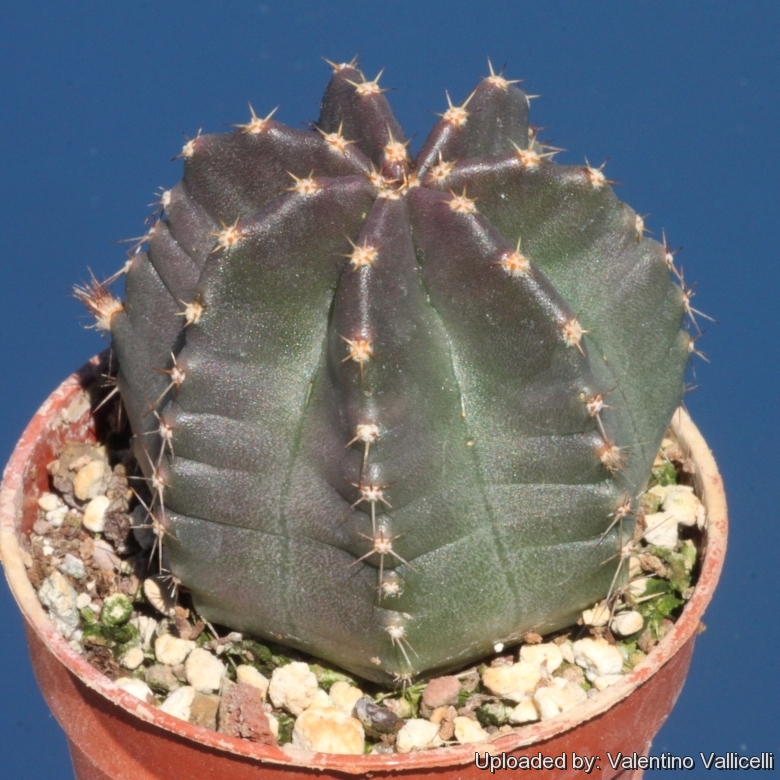= Echinocereus subinermis var. luteus (Britton & Rose) F.M.Knuth
Kaktus-ABC [Backeb. & Knuth] 312. 1936 [12 Feb 1936] Backeb., F.M.Knuth
Accepted Scientific Name: Echinocereus subinermis Salm-Dyck in Seem. ex Scheer
Bot. Voy. Herald [Seemann] 7-8: 291. 1856 Seem.

Echinocereus luteus (Echinocereus subinermis var. luteus) Photo by: Valentino Vallicelli
Synonyms:
See all synonyms of Echinocereus subinermis
Description: Echinocereus subinermisSN|16544]]SN|16544]] var. luteus (ayn: Echinocereus luteusSN|16544]]SN|16546]]), is one of the morphological or local forms of Echinocereus subinermisSN|16546]]SN|16544]], and the two plants are not readily distinguishable, if not for the geographical provenance. More likely they are one and the same species and most authors have dismissed E. luteus as perhaps not worthy of even varietal status. Echinocereus subinermisSN|16544]]SN|16544]] var. luteus is a beautiful golden-flowered cactus with bluish green, more or less purplish, stems. Old individuals attain a height of 30 cm rarely, and the plant rarely branches once or twice from the main stem. The stem is oval to conical shaped, 8 to 9 ribbed, with very small spines. Flowers are yellow and outer petals are tinged with red colour, and fragrant. The spines on flower-tube and ovary are acicular.
Stem:* Short to elongated up to 30 cm tall, generally solitary, sometimes branching near base, bluish green, more or less purplish, 8 strongly or 9-ribbed.
Ribs: Rather thin, hardly, if at all, undulate, rounded.
Areoles: Small, 10 to 12 mm apart.
Spines: Small, the radials 6 to 8, unequal, 2 to 8 mm long, widely spreading, white with darker tips.
Central spine: Usually missing, if present, single, and porrect.
Flowers: On each rib appearing near top of plant and from second or third areole. Flower-buds acute, reddish, covered with long, brownish bristles; areoles on ovary and flower-tube bearing white wool and light-coloured acicular spines with dark tips; flowers pale yellow, delicately sweet-scented, 7 cm long, including the ovary. Outer perianth segments streaked with red. Inner perianth segments lemon-yellow, oblanceolate, acute. Filaments light yellow, stigmas deep green.
Subspecies, varieties, forms and cultivars of plants belonging to the Echinocereus subinermis group
 Echinocereus subinermis Salm-Dyck in Seem. ex Scheer: with usually solitary stems (or with very few branches) often spineless with 5-9 ribs. the floral tube is only slightly woolly (from northern Sinaloa, southern Sonora, south-western Chihuahua)
Echinocereus subinermis Salm-Dyck in Seem. ex Scheer: with usually solitary stems (or with very few branches) often spineless with 5-9 ribs. the floral tube is only slightly woolly (from northern Sinaloa, southern Sonora, south-western Chihuahua) Echinocereus subinermis var. luteus (Britton & Rose) F.M.Knuth: from Sonora and Sinaloa, is generally solitary, has 8 or 9 ribs, no central spine, 6 to 8 radials, up to 8 mm long.
Echinocereus subinermis var. luteus (Britton & Rose) F.M.Knuth: from Sonora and Sinaloa, is generally solitary, has 8 or 9 ribs, no central spine, 6 to 8 radials, up to 8 mm long. Echinocereus subinermis subs. ochoterenae (J.G.Ortega) N.P.Taylor: With branched stems, always spiny with 8 to 11 ribs. the flower tube is noticeably woolly (From northern Sinaloa).
Echinocereus subinermis subs. ochoterenae (J.G.Ortega) N.P.Taylor: With branched stems, always spiny with 8 to 11 ribs. the flower tube is noticeably woolly (From northern Sinaloa). Echinocereus subinermis cv. Spiral: has spiral schaped ribs.
Echinocereus subinermis cv. Spiral: has spiral schaped ribs.
Bibliography: Major references and further lectures
1) Nathaniel Lord Britton, Joseph Nelson Rose “Cactaceae: Descriptions and Illustrations of Plants of the Cactus Family” Volume 3, 1922
2) Howard Scott Gentry “Rio Mayo Plants: A Study of the Flora and Vegetation of the Valley of the Rio Mayo, Sonora” Carnegie Institution of Washington, 1942
3) Supriya Kumar Bhattacharjee “Handbook of aromatic plants” Pointer Publishers, 2000
4) Nathaniel Lord Britton, Joseph Nelson Rose “Smithsonian Institution United States National Museum Contributions from the United States National Herbarium”, volume 16, part 7 “Studies in Cactaceae-1”, page 239, Plate 67, Washington Government Printing Office 1913
Cultivation and Propagation: This cactus is cultivated and highly priced for its flowers. It is among the easiest species to grow, flower and propagate.
Waterings: Water regularly from March to October. Rot prone in winter, it needs good drainage.
Hardiness: It can not tolerate much frost. Frost Tolerance: Hardy to -2° C.
Exposition: It does not like full harsh sun as it seems to have a delicate skin and few spines, so give it a protected position in the partial-shade or under filtered sun.
Propagation: Seeds (usually), it also can be grown from cuttings, as it can branch from the base.










